As AI assistants evolve, GPT-5 and Claude Sonnet 4.5 stand out as the most capable large language models yet. Dive in and see how they stack up.
Keep reading
2025 has been a defining year for AI. OpenAI’s GPT-5 and Anthropic’s Claude Sonnet 4.5 have raised the bar once again, each one aiming to blend stronger reasoning, longer memory, and more autonomy into one seamless system. Both are built to handle coding, research, writing, and enterprise-scale tasks, yet their design philosophies differ sharply.
This breakdown explores how the two stack up across performance, reasoning, coding, math, efficiency, and cost, helping users and teams decide where each model truly shines.
A Quick Overview
Claude Sonnet 4.5 builds on Anthropic’s refined Claude family. It extends memory across sessions, handles million-token contexts via Amazon Bedrock and Vertex AI, and features smart context management that prevents sudden cut-offs. It can run autonomously for 30 hours on extended tasks, making it ideal for ongoing workflows.
Meanwhile, GPT-5 is OpenAI’s flagship successor to GPT-4, tuned for agentic reasoning, where the model plans, executes, and coordinates tools on its own. Its adaptive reasoning system dynamically chooses between shallow or deep “thinking” paths, letting users balance speed, cost, and depth per task. GPT-5 also offers specialized variants (Mini, Nano) for lighter workloads.
Reasoning and Analysis
Both models far exceed their 2024 counterparts, but they differ in how they reason.
GPT-5’s deep-reasoning mode significantly boosts performance in multi-step logic, scientific, and spatial tasks. It can break problems into chains, test sub-hypotheses, and self-correct mid-process. However, disabling this mode reduces accuracy sharply, it can be brilliant when “thinking deeply,” but more variable when not.
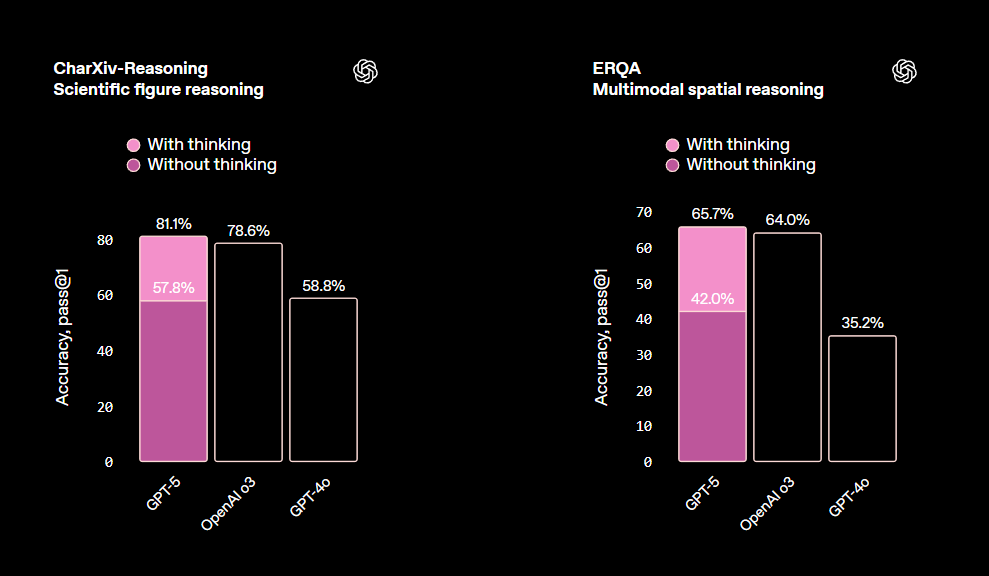
Claude Sonnet 4.5, by contrast, stays stable even without added configuration. It’s particularly strong in financial, policy, and business logic, where structure and coherence matter more than creative leaps. For enterprise Q&A or decision support, that predictability is valuable.

If you want an AI that reasons steadily, Claude takes the lead. If you need exploratory logic (i.e. complex hypothesis testing or cross-domain synthesis) GPT-5’s deeper path is unmatched.
Math and Structured Problem Solving
As seen in the benchmarks provided by Anthropic, Claude Sonnet 4.5 continues its consistency streak. Whether calculating directly or using Python tools, it achieves top-tier math accuracy. This means it handles structured logic even in constrained environments.
GPT-5 also reaches near-perfect accuracy, but only when tool use and reasoning depth are active. Disable them, and results drop noticeably. It relies heavily on its reasoning pipeline to stay sharp.
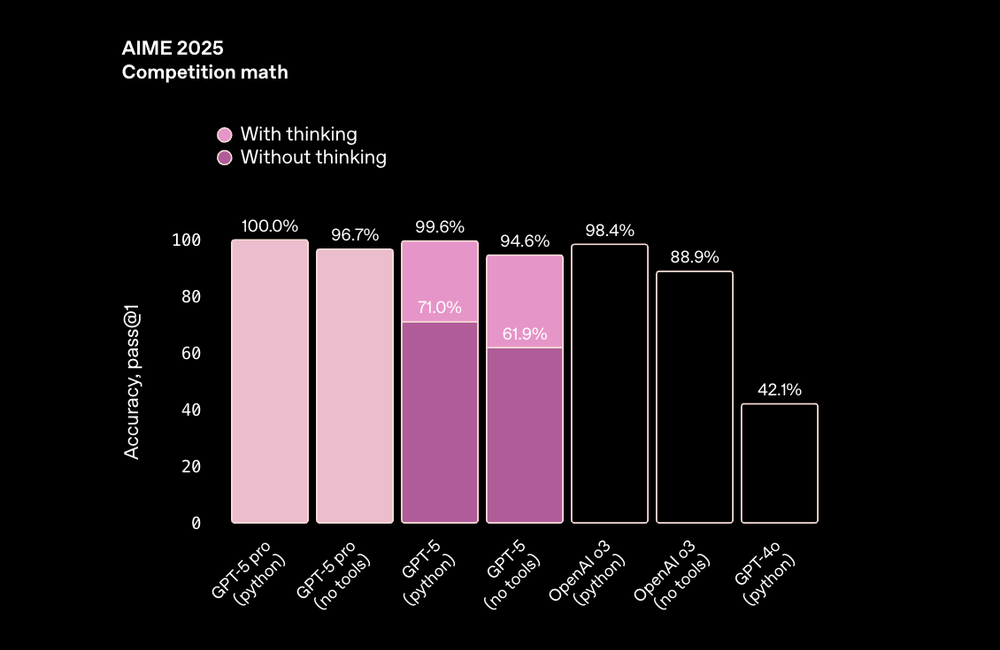
Verdict:
- Claude Sonnet 4.5: dependable out-of-the-box math solver.
- GPT-5: flexible but needs tuning to perform at its best.
Coding and Software Engineering
When it comes to coding, the two models diverge in style.
Claude Sonnet 4.5 delivers stable performance without special tuning. In tests resembling HumanEval+ and MBPP+, it maintains high accuracy across conditions, making it dependable for production pipelines. Its strength lies in consistency, results rarely fluctuate, which is crucial for enterprise use.

By contrast, GPT-5 achieves higher peak scores when its advanced reasoning is enabled, especially in multi-language or large-project contexts. In JavaScript and Python refactoring tasks, for instance, it outperformed Sonnet when its “high-reasoning” mode was active — though baseline runs without that mode varied more.
For agentic coding, where the AI calls external tools or terminals, Sonnet 4.5 often executes with fewer dropped commands. GPT-5, on the other hand, can chain more tool calls simultaneously, making it better for complex orchestration, provided you configure it carefully.
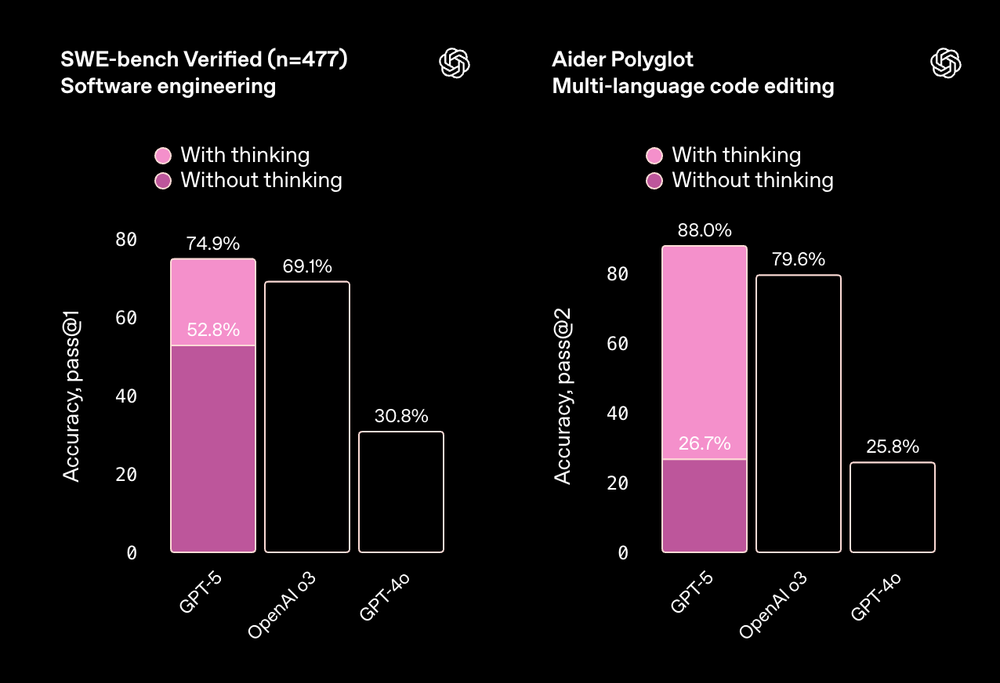
Verdict:
- Claude Sonnet 4.5: predictable, steady engineering partner.
- GPT-5: versatile powerhouse, but performance hinges on setup.
Cost and Efficiency
GPT-5 is clearly cheaper per token, particularly for large inputs. Its adaptive router also saves compute by running simple prompts on lighter paths.
Claude Sonnet 4.5 charges more but maintains predictable latency, a key factor for production environments that value reliability over marginal savings. For very large prompts, its cost rises faster than GPT-5’s, though batch discounts narrow the gap.
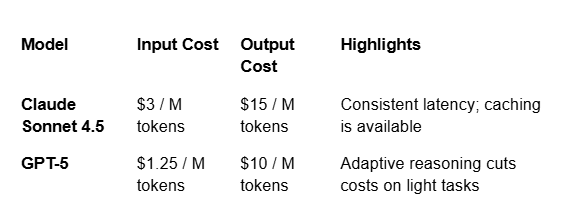
TL;DR: GPT-5 wins on price and scalability, whereas Claude wins on timing consistency and stability.
Pricing for Premium Plans
Beyond API access, both OpenAI and Anthropic offer premium subscriptions for individual users, which differ in features and pricing.
ChatGPT Plus, powered by GPT-5, is priced at $20 per month, giving users priority access to GPT-5, faster response times, and early access to new features and memory. OpenAI’s unified ChatGPT experience also includes file uploads, image generation, and custom GPTs.
Claude Pro, meanwhile, costs $20 per month as well and grants access to Claude Sonnet 4.5, offering faster responses, higher rate limits, and longer context windows. While it lacks built-in multimodal tools, Claude focuses on text clarity and structured reasoning, appealing to researchers, analysts, and writers seeking dependability over versatility.
TL;DR: both Plus plans are tied in price; what sets them apart, however, is their offering.
Different Strengths for Different Needs
It’s tempting to crown one “best,” but GPT-5 and Claude Sonnet 4.5 serve different priorities for different users and teams.
- Claude Sonnet 4.5: best for reliability and sustained performance. If you want consistent outputs and clear memory behavior, Claude delivers.
- GPT-5: best for depth, flexibility, and scalability. When configured properly, it surpasses rivals in creative reasoning, multimodal integration, and adaptive tool use.
Most teams may find the strongest setup is multi-model, using Claude where consistency matters most, and GPT-5 for data-intensive workflows.
Ultimately, these aren’t just chatbots anymore, they’re full-fledged digital collaborators, each with distinct personalities. Claude Sonnet 4.5 is your calm, methodical analyst. GPT-5 is your ambitious polymath. Which one you pick depends less on their individual benchmarks and more on your mission.
NEWS AND UPDATES
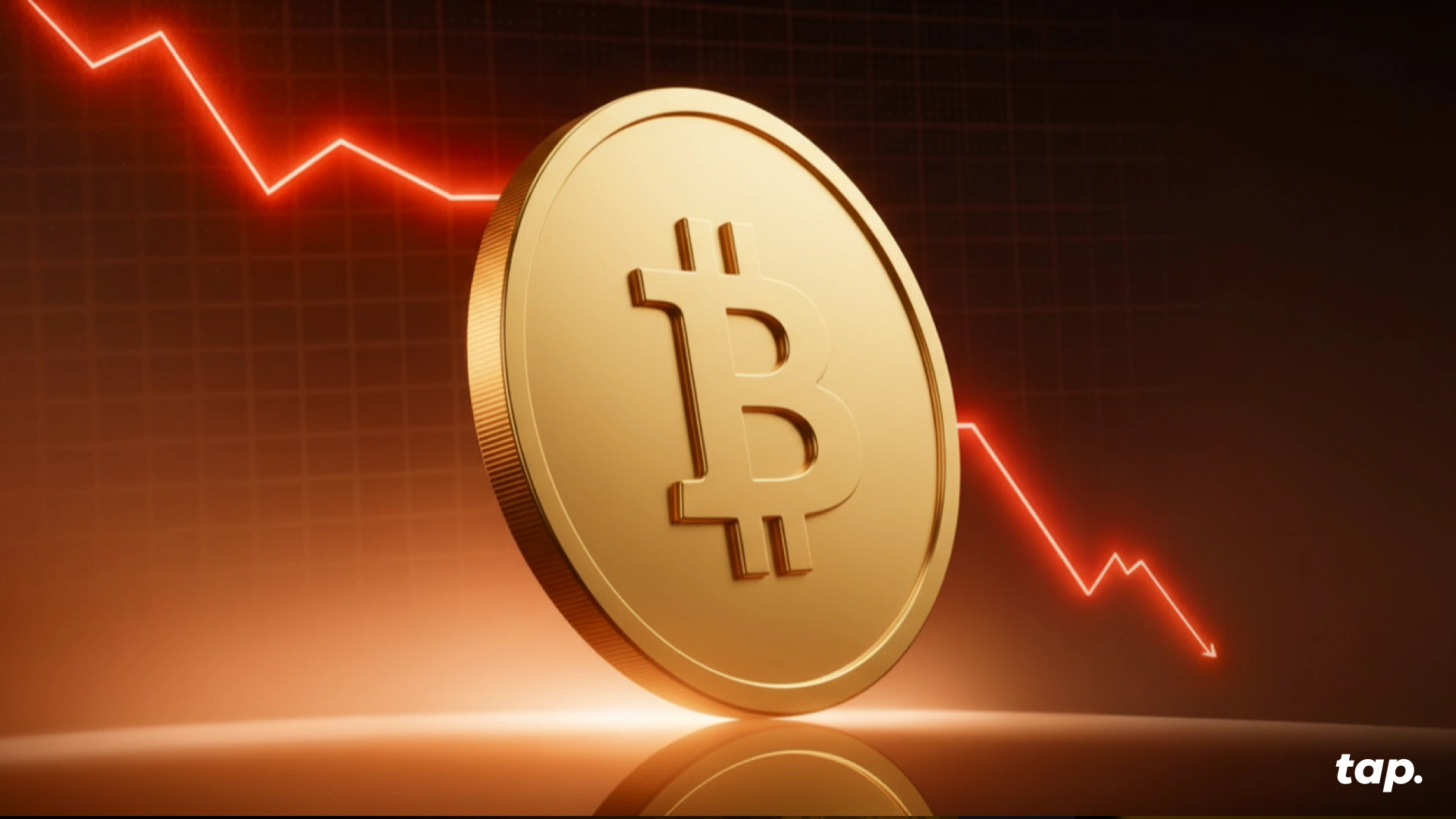
After a brutal October sell-off, crypto just staged one of its most dramatic comebacks yet. Here's what the market's resilience signals for what comes next.
The crypto market just pulled off one of its boldest recoveries in recent memory. What began as a violent sell-off on October 10 has given way to a surprisingly strong rebound. In this piece, we’ll dig into “The Great Recovery” of the crypto market, how Bitcoin’s resilience particularly stands out in this comeback, and what to expect next…
The Crash That Shook It All
On October 10, markets were rattled across the board. Bitcoin fell from around $122,000 down to near $109,000 in a matter of hours. Ethereum dropped into the $3,600 to $3,700 range. The sudden collapse triggered massive liquidations, nearly $19 billion across assets, with $16.7B in long positions wiped out.
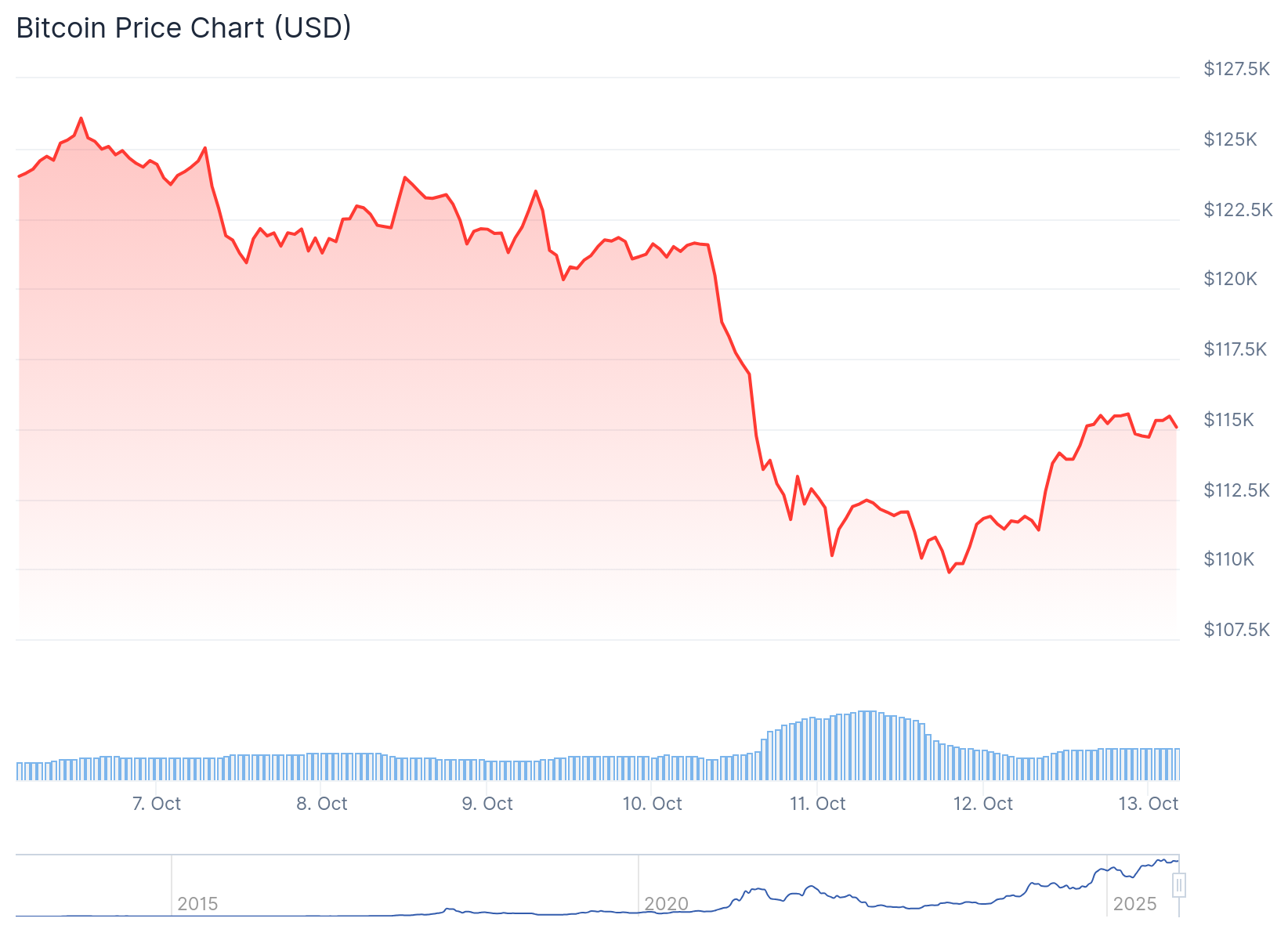
That kind of forced selling, often magnified by leverage and thin liquidity, created a sharp vacuum. Some call it a “flash crash”; an overreaction to geopolitical news, margin stress, and cascading liquidations.
What’s remarkable, however, is how quickly the market recovered.
The Great Recovery: Scope and Speed
Within days, many major cryptocurrencies recouped large parts of their losses. Bitcoin climbed back above $115,000, and Ethereum surged more than 8%, reclaiming the $4,100 level and beyond. Altcoins like Cardano and Dogecoin led some of the strongest rebounds.
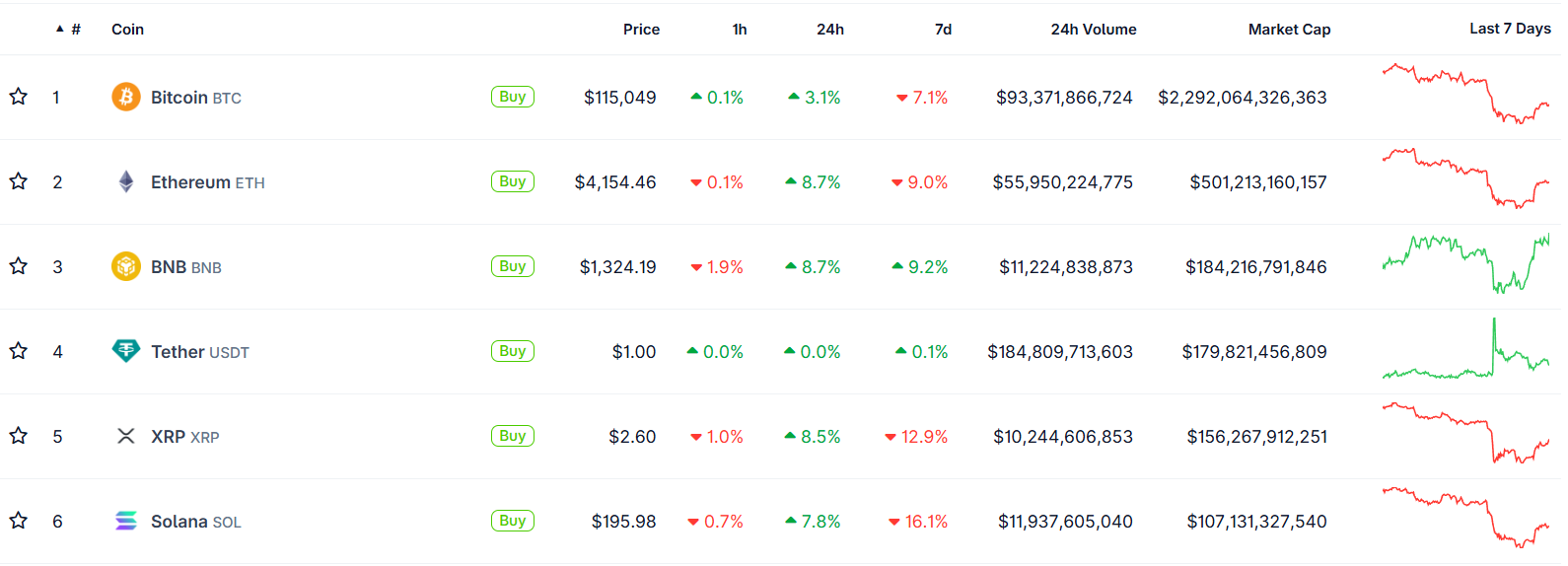
One narrative gaining traction is that this crash was not a structural breakdown but a “relief rally”, a market reset after overleveraged participants were squeezed out of positions. Analysts highlight that sell pressure has eased, sentiment is stabilizing, and capital is re-entering the market, all signs that the broader uptrend may still be intact.
“What we just saw was a massive emotional reset,” Head of Partnerships at Arctic Digital Justin d’Anethan said.
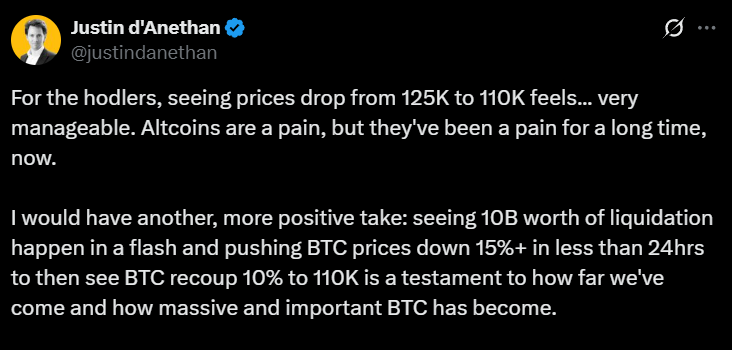
“I would have another, more positive take: seeing 10B worth of liquidation happen in a flash and pushing BTC prices down 15%+ in less than 24hrs to then see BTC recoup 10% to 110K is a testament to how far we've come and how massive and important BTC has become,” he posted on 𝕏.
Moreover, an important datapoint stands out. Exchange inflows to BTC have shrunk, signaling that fewer holders are moving coins to exchanges for sale. This signals that fewer investors are transferring their Bitcoin from personal wallets to exchanges, which is a common precursor to selling. In layman terms, coins are being held rather than prepared for trade.
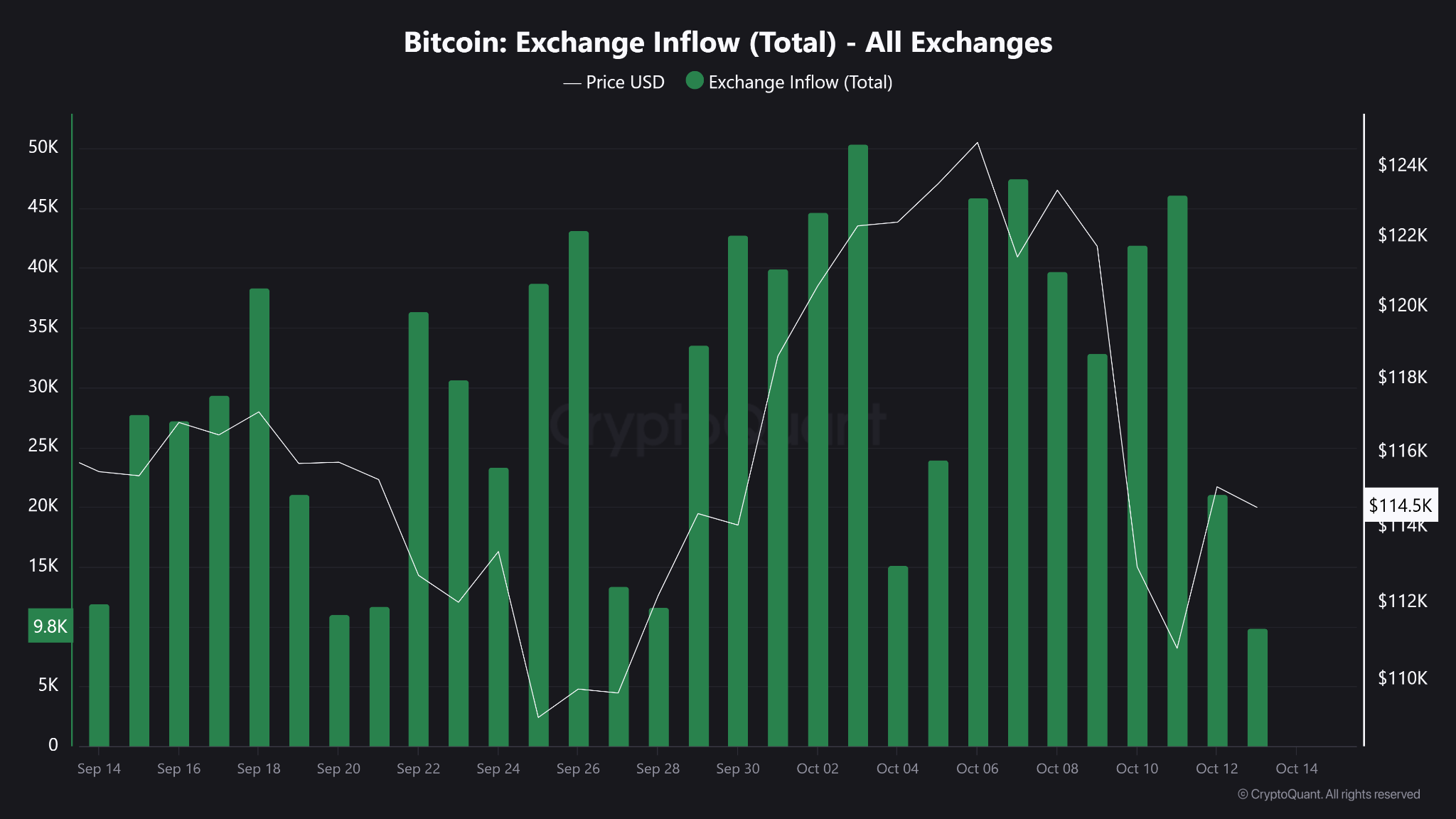
Bitcoin’s Backbone: Resilience Under Pressure
Bitcoin’s ability to rebound after extreme volatility has long been one of its defining traits. Friday’s drop admittedly sent shockwaves through the market, triggering billions in liquidations and exposing the fragility of leveraged trading.
Yet, as history has shown, such sharp pullbacks are far from new for the world’s largest cryptocurrency. In its short history, Bitcoin has endured dozens of drawdowns exceeding 10% in a single day (from the infamous “COVID crash” of 2020 to the FTX collapse in 2022) only to recover and set new highs months later.
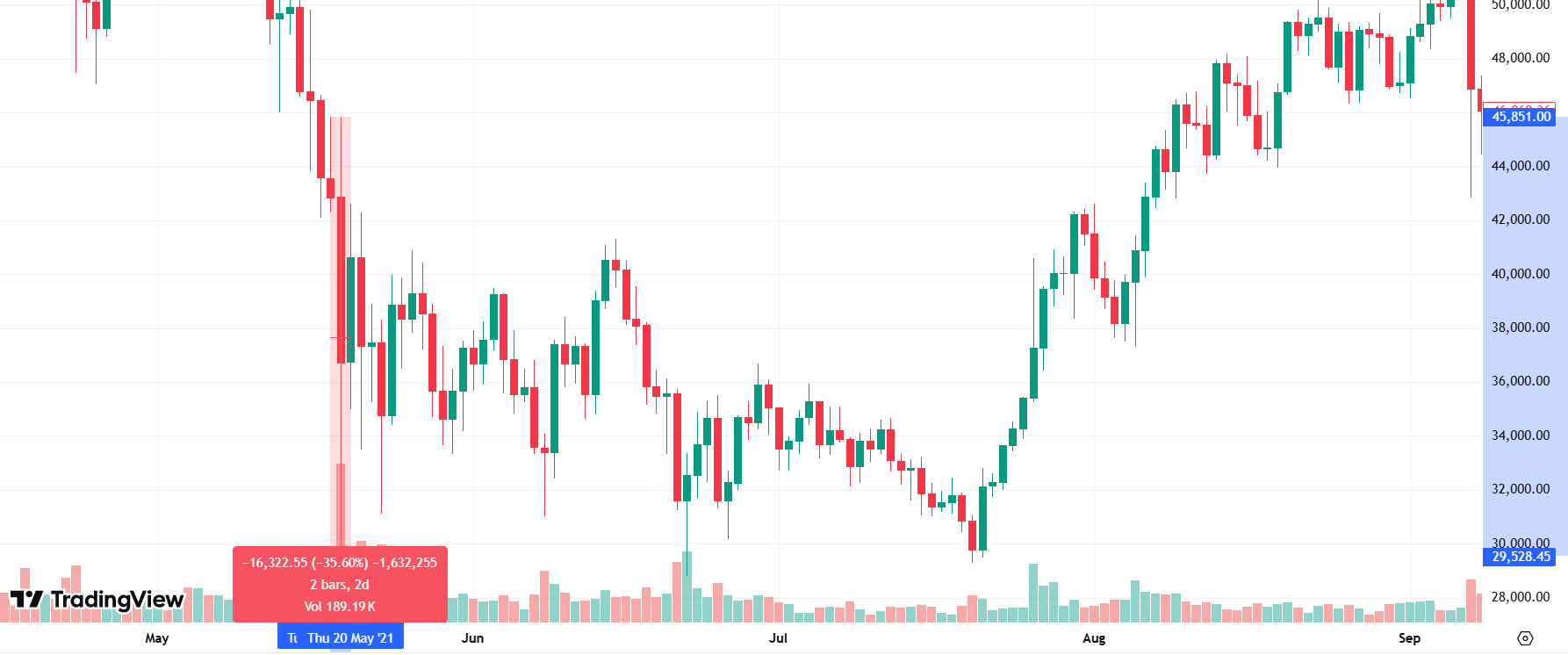
This latest event, while painful, highlights a maturing market structure. Since the approval of spot Bitcoin ETFs in early 2024, institutional involvement has deepened, creating greater liquidity buffers and stronger institutional confidence. Even as billions in leveraged positions were wiped out, Bitcoin has held firm around the $110,000 zone, a level that has since acted as psychological support.
What to Watch Next
The key question now is whether this rebound marks a short-term relief rally or the start of a renewed uptrend. Analysts are closely watching derivatives funding rates, on-chain flows, and ETF inflows for clues. A sustained increase in ETF demand could provide a steady bid under the market, offsetting the effects of future liquidation cascades. Meanwhile, Bitcoin’s ability to hold above $110,000 (an area of heavy trading volume) may serve as confirmation that investor confidence remains intact.
As the market digests the events of October 10, one lesson stands out. Bitcoin’s recovery isn’t just a matter of luck, it’s a reflection of underlying market structure that can absorb shocks. It is built on a growing base of long-term holders, institutional adoption, and a financial system increasingly intertwined with digital assets. Corrections, however dramatic, are not signs of weakness; they are reminders of a maturing market that is striding towards equilibrium.
Bottom Line
The crash on October 10 was brutal, there’s no denying that. It was one of the deepest and fastest in recent memory. But the recovery has been equally sharp. Rather than exposing faults, the rebound has underscored the market’s adaptability and Bitcoin’s central role.
The market consensus is seemingly leaning towards a reset; not a reversal. The shakeout purged excess leverage, and the comeback underlined demand. If Bitcoin can maintain that strength, and the broader market keeps its footing in the coming days, this could mark a turning point rather than a cave-in.

What's driving the crypto market this week? Get fast, clear updates on the top coins, market trends, and regulation news.
Welcome to Tap’s weekly crypto market recap.
Here are the biggest stories from last week (8 - 14 July).
💥 Bitcoin breaks new ATH
Bitcoin officially hit above $122,000 marking its first record since May and pushing total 2025 gains to around +20% YTD. The rally was driven by heavy inflows into U.S. spot ETFs, over $218m into BTC and $211m into ETH in a single day, while nearly all top 100 coins turned green.
📌 Trump Media files for “Crypto Blue‑Chip ETF”
Trump Media & Technology Group has submitted an S‑1 to the SEC for a new “Crypto Blue Chip ETF” focused primarily on BTC (70%), ETH (15%), SOL (8%), XRP (5%), and CRO (2%), marking its third crypto ETF push this year.
A major political/media player launching a multi-asset crypto fund signals growing mainstream and institutional acceptance, and sparks fresh conflict-of-interest questions. We’ll keep you updated.
🌍 Pakistan launches CBDC pilot & virtual‑asset regulation
The State Bank of Pakistan has initiated a pilot for a central bank digital currency and is finalising virtual-asset laws, with Binance CEO CZ advising government efforts. With inflation at just 3.2% and rising foreign reserves (~$14.5b), Pakistan is embracing fintech ahead of emerging-market peers like India.
🛫 Emirates Airline to accept crypto payments
Dubai’s Emirates signed a preliminary partnership with Crypto.com to enable crypto payments starting in 2026, deepening the Gulf’s commitment to crypto-friendly infrastructure.
*Not to take away from the adoption excitement, but you can book Emirates flights with your Tap card, using whichever crypto you like.
🏛️ U.S. declares next week “Crypto Week”
House Republicans have designated 14-18 July as “Crypto Week,” aiming for votes on GENIUS (stablecoin oversight), CLARITY (jurisdiction clarity), and Anti‑CBDC bills. The idea is that these bills could reshape how U.S. defines crypto regulation and limit federal CBDC initiatives under Trump-aligned priorities.
Stay tuned for next week’s instalment, delivered on Monday mornings.

Explore key catalysts driving the modern money revolution. Learn about digital currencies, fintech innovation, and the future of finance.
The financial world is undergoing a significant transformation, largely driven by Millennials and Gen Z. These digital-native generations are embracing cryptocurrencies at an unprecedented rate, challenging traditional financial systems and catalysing a shift toward new forms of digital finance, redefining how we perceive and interact with money.
This movement is not just a fleeting trend but a fundamental change that is redefining how we perceive and interact with money.
Digital Natives Leading the Way
Growing up in the digital age, Millennials (born 1981-1996) and Gen Z (born 1997-2012) are inherently comfortable with technology. This familiarity extends to their financial behaviours, with a noticeable inclination toward adopting innovative solutions like cryptocurrencies and blockchain technology.
According to the Grayscale Investments and Harris Poll Report which studied Americans, 44% agree that “crypto and blockchain technology are the future of finance.” Looking more closely at the demographics, Millenials and Gen Z’s expressed the highest levels of enthusiasm, underscoring the pivotal role younger generations play in driving cryptocurrency adoption.
Desire for Financial Empowerment and Inclusion
Economic challenges such as the 2008 financial crisis and the impacts of the COVID-19 pandemic have shaped these generations' perspectives on traditional finance. There's a growing scepticism toward conventional financial institutions and a desire for greater control over personal finances.
The Grayscale-Harris Poll found that 23% of those surveyed believe that cryptocurrencies are a long-term investment, up from 19% the previous year. The report also found that 41% of participants are currently paying more attention to Bitcoin and other crypto assets because of geopolitical tensions, inflation, and a weakening US dollar (up from 34%).
This sentiment fuels engagement with cryptocurrencies as viable investment assets and tools for financial empowerment.
Influence on Market Dynamics
The collective financial influence of Millennials and Gen Z is significant. Their active participation in cryptocurrency markets contributes to increased liquidity and shapes market trends. Social media platforms like Reddit, Twitter, and TikTok have become pivotal in disseminating information and investment strategies among these generations.
The rise of cryptocurrencies like Dogecoin and Shiba Inu demonstrates how younger investors leverage online communities to impact financial markets2. This phenomenon shows their ability to mobilise and drive market movements, challenging traditional investment paradigms.
Embracing Innovation and Technological Advancement
Cryptocurrencies represent more than just investment opportunities; they embody technological innovation that resonates with Millennials and Gen Z. Blockchain technology and digital assets are areas where these generations are not only users but also contributors.
A 2021 survey by Pew Research Center indicated that 31% of Americans aged 18-29 have invested in, traded, or used cryptocurrency, compared to just 8% of those aged 50-64. This significant disparity highlights the generational embrace of digital assets and the technologies underpinning them.
Impact on Traditional Financial Institutions
The shift toward cryptocurrencies is prompting traditional financial institutions to adapt. Banks, investment firms, and payment platforms are increasingly integrating crypto services to meet the evolving demands of younger clients.
Companies like PayPal and Square have expanded their cryptocurrency offerings, allowing users to buy, hold, and sell cryptocurrencies directly from their platforms. These developments signify the financial industry's recognition of the growing importance of cryptocurrencies.
Challenges and Considerations
While enthusiasm is high, challenges such as regulatory uncertainties, security concerns, and market volatility remain. However, Millennials and Gen Z appear willing to navigate these risks, drawn by the potential rewards and alignment with their values of innovation and financial autonomy.
In summary
Millennials and Gen Z are redefining the financial landscape, with their embrace of cryptocurrencies serving as a catalyst for broader change. This isn't just about alternative investments; it's a shift in how younger generations view financial systems and their place within them. Their drive for autonomy, transparency, and technological integration is pushing traditional institutions to innovate rapidly.
This generational influence extends beyond personal finance, potentially reshaping global economic structures. For industry players, from established banks to fintech startups, adapting to these changing preferences isn't just advantageous—it's essential for long-term viability.
As cryptocurrencies and blockchain technology mature, we're likely to see further transformations in how society interacts with money. Those who can navigate this evolving landscape, balancing innovation with stability, will be well-positioned for the future of finance. It's a complex shift, but one that offers exciting possibilities for a more inclusive and technologically advanced financial ecosystem. The financial world is changing, and it's the young guns who are calling the shots.
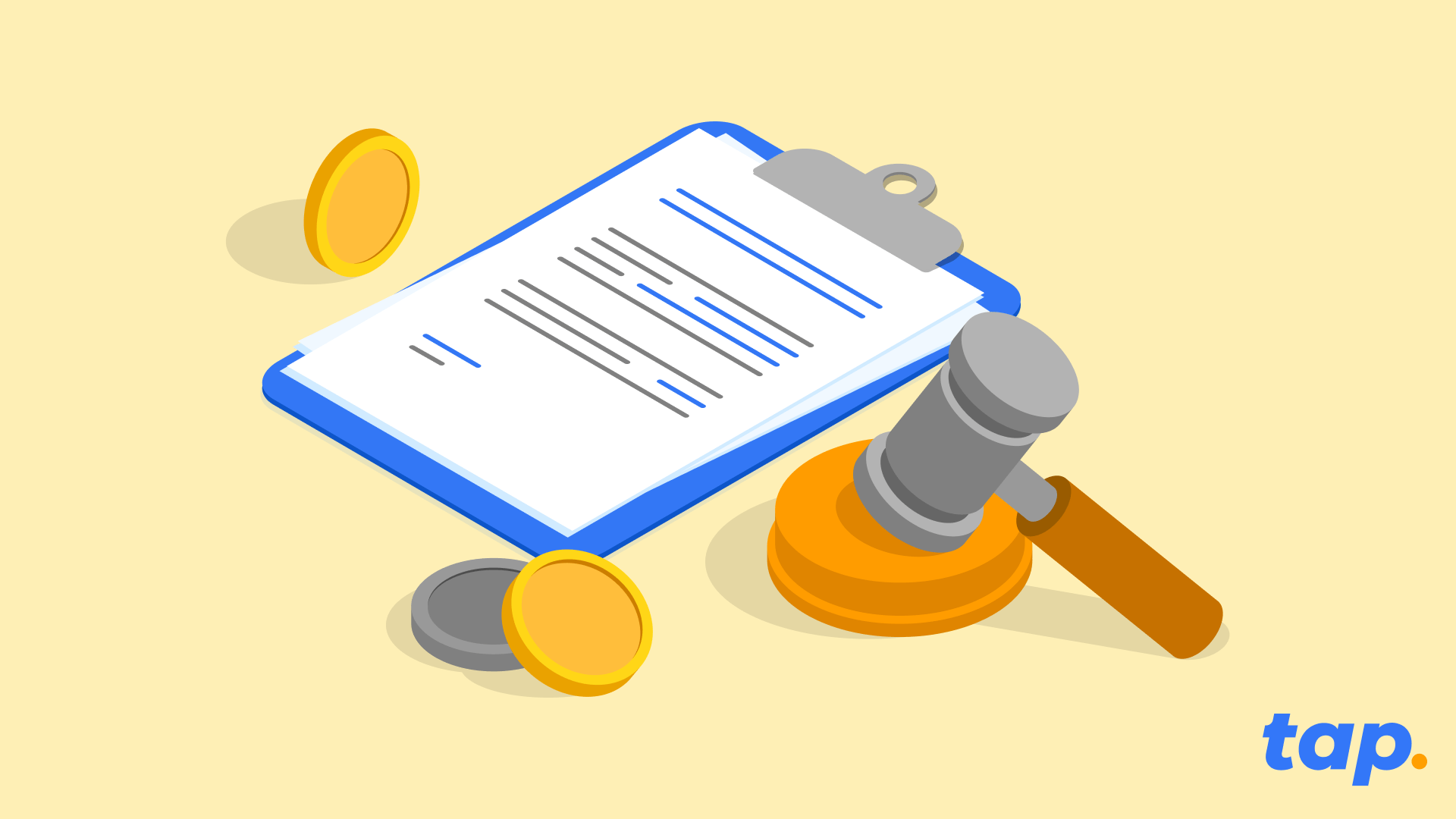
You might have heard of the "Travel Rule" before, but do you know what it actually mean? Let us dive into it for you.
What is the "Travel Rule"?
You might have heard of the "Travel Rule" before, but do you know what it actually mean? Well, let me break it down for you. The Travel Rule, also known as FATF Recommendation 16, is a set of measures aimed at combating money laundering and terrorism financing through financial transactions.
So, why is it called the Travel Rule? It's because the personal data of the transacting parties "travels" with the transfers, making it easier for authorities to monitor and regulate these transactions. See, now it all makes sense!
The Travel Rule applies to financial institutions engaged in virtual asset transfers and crypto companies, collectively referred to as virtual asset service providers (VASPs). These VASPs have to obtain and share "required and accurate originator information and required beneficiary information" with counterparty VASPs or financial institutions during or before the transaction.
To make things more practical, the FATF recommends that countries adopt a de minimis threshold of 1,000 USD/EUR for virtual asset transfers. This means that transactions below this threshold would have fewer requirements compared to those exceeding it.
For transfers of Virtual Assets falling below the de minimis threshold, Virtual Asset Service Providers (VASPs) are required to gather:
- The identities of the sender (originator) and receiver (beneficiary).
- Either the wallet address associated with each transaction involving Virtual Assets (VAs) or a unique reference number assigned to the transaction.
- Verification of this gathered data is not obligatory, unless any suspicious circumstances concerning money laundering or terrorism financing arise. In such instances, it becomes essential to verify customer information.
Conversely, for transfers surpassing the de minimis threshold, VASPs are obligated to collect more extensive particulars, encompassing:
- Full name of the sender (originator).
- The account number employed by the sender (originator) for processing the transaction, such as a wallet address.
- The physical (geographical) address of the sender (originator), national identity number, a customer identification number that uniquely distinguishes the sender to the ordering institution, or details like date and place of birth.
- Name of the receiver (beneficiary).
- Account number of the receiver (beneficiary) utilized for transaction processing, similar to a wallet address.
By following these guidelines, virtual asset service providers can contribute to a safer and more transparent virtual asset ecosystem while complying with international regulations on anti-money laundering and countering the financing of terrorism. It's all about ensuring the integrity of financial transactions and safeguarding against illicit activities.
Implementation of the Travel Rule in the United Kingdom
A notable shift is anticipated in the United Kingdom's oversight of the virtual asset sector, commencing September 1, 2023.
This seminal development comes in the form of the Travel Rule, which falls under Part 7A of the Money Laundering Regulations 2017. Designed to combat money laundering and terrorist financing within the virtual asset industry, this new regulation expands the information-sharing requirements for wire transfers to encompass virtual asset transfers.
The HM Treasury of the UK has meticulously customized the provisions of the revised Wire Transfer Regulations to cater to the unique demands of the virtual asset sector. This underscores the government's unwavering commitment to fostering a secure and transparent financial ecosystem. Concurrently, it signals their resolve to enable the virtual asset industry to flourish.
The Travel Rule itself originates from the updated version of the Financial Action Task Force's recommendation on information-sharing requirements for wire transfers. By extending these recommendations to cover virtual asset transfers, the UK aspires to significantly mitigate the risk of illicit activities within the sector.
Undoubtedly, the Travel Rule heralds a landmark stride forward in regulating the virtual asset industry in the UK. By extending the ambit of information-sharing requirements and fortifying oversight over virtual asset firms
Implementation of the Travel Rule in the European Union
Prepare yourself, as a new regulation called the Travel Rule is set to be introduced in the world of virtual assets within the European Union. Effective from December 30, 2024, this rule will take effect precisely 18 months after the initial enforcement of the Transfer of Funds Regulation.
Let's delve into the details of the Travel Rule. When it comes to information requirements, there will be no distinction made between cross-border transfers and transfers within the EU. The revised Transfer of Funds regulation recognizes all virtual asset transfers as cross-border, acknowledging the borderless nature and global reach of such transactions and services.
Now, let's discuss compliance obligations. To ensure adherence to these regulations, European Crypto Asset Service Providers (CASPs) must comply with certain measures. For transactions exceeding 1,000 EUR with self-hosted wallets, CASPs are obligated to collect crucial originator and beneficiary information. Additionally, CASPs are required to fulfill additional wallet verification obligations.
The implementation of these measures within the European Union aims to enhance transparency and mitigate potential risks associated with virtual asset transfers. For individuals involved in this domain, it is of utmost importance to stay informed and adhere to these new guidelines in order to ensure compliance.
What does the travel rules means to me as user?
As a user in the virtual asset industry, the implementation of the Travel Rule brings some significant changes that are designed to enhance the security and transparency of financial transactions. This means that when you engage in virtual asset transfers, certain personal information will now be shared between the involved parties. While this might sound intrusive at first, it plays a crucial role in combating fraud, money laundering, and terrorist financing.
The Travel Rule aims to create a safer environment for individuals like you by reducing the risks associated with illicit activities. This means that you can have greater confidence in the legitimacy of the virtual asset transactions you engage in. The regulation aims to weed out illicit activities and promote a level playing field for legitimate users. This fosters trust and confidence among users, attracting more participants and further driving the growth and development of the industry.
However, it's important to note that complying with this rule may require you to provide additional information to virtual asset service providers. Your privacy and the protection of your personal data remain paramount, and service providers are bound by strict regulations to ensure the security of your information.
In summary, the Travel Rule is a positive development for digital asset users like yourself, as it contributes to a more secure and trustworthy virtual asset industry.
Unlocking Compliance and Seamless Experiences: Tap's Proactive Approach to Upcoming Regulations
Tap is fully committed to upholding regulatory compliance, while also prioritizing a seamless and enjoyable customer experience. In order to achieve this delicate balance, Tap has proactively sought out partnerships with trusted solution providers and is actively engaged in industry working groups. By collaborating with experts in the field, Tap ensures it remains on the cutting edge of best practices and innovative solutions.
These efforts not only demonstrate Tap's dedication to compliance, but also contribute to creating a secure and transparent environment for its users. By staying ahead of the curve, Tap can foster trust and confidence in the cryptocurrency ecosystem, reassuring customers that their financial transactions are safe and protected.
But Tap's commitment to compliance doesn't mean sacrificing user experience. On the contrary, Tap understands the importance of providing a seamless journey for its customers. This means that while regulatory requirements may be changing, Tap is working diligently to ensure that users can continue to enjoy a smooth and hassle-free experience.
By combining a proactive approach to compliance with a determination to maintain user satisfaction, Tap is setting itself apart as a trusted leader in the financial technology industry. So rest assured, as Tap evolves in response to new regulations, your experience as a customer will remain top-notch and worry-free.
LATEST ARTICLE

While you’ve likely come across the world of cryptocurrencies, you most probably have stumbled upon the term “blockchain”. But what is the blockchain solution? Blockchain is not only the revolutionary technology behind cryptocurrencies, it also has a large use case outside of the cryptocurrency and even the finance sector.
In the decade since blockchain technologies and digital ledger technology came to light, a host of blockchain networks have been created, most with their own digital currency. As the industry has grown and new blockchain networks have emerged, innovation in the space has increased significantly.
From the Ethereum blockchain providing a platform on which developers can create digital assets and smart contracts to corporate organizations implementing a private blockchain in order to streamline their services, the technology is propelling mankind forward in ways not witnessed in decades.
The blockchain solution provides much more than just digital assets, and industries far beyond just the payment processing ones are catching on. With traditional business networks incorporating the technology, the world of permissioned blockchain is igniting.
What is Blockchain?
Blockchain is a decentralized, transparent, immutable technology that keeps a public record of all information entered. Designed to record and distribute information, not to be edited. Also referred to as a public ledger, a blockchain keeps a record of all information ever inputted and stores it chronologically in blocks.
These blocks are linked to each other through a hashing system, which ensures that no one can ever tamper with the previous records, or try to manipulate the information on them. The “chain” of blocks make up the blockchain database.
The decentralized technology is not typically run by one entity, but rather from a variety of computers (also known as nodes) that make up the network, and work together to validate transactions and all information added to the blocks. Blockchain can be used in two forms, as a public blockchain or as private blockchain networks.
The public version allows anyone to view all information on the network, while the private reserves the information for members granted access.
The Advantages of Blockchain Technology
Powerful Technology
Invented in 2008 alongside Bitcoin by an anonymous entity Satoshi Nakamoto, blockchain is the technology that fueled the new way that money is transacted. Not only that, the technology offers incredible use cases far beyond the financial world.
Fully Trusted, Fully Automated
One of the key features of blockchain is its ability to function without a central authority. The technology is designed to be maintained by various operating systems on the network, with full autonomy dispersed evenly. Information is stored on the blockchain in such a way that everyone can view it but no one can go back and tamper with it.
Powering Industries
While blockchain is the technology behind crypto, it also offers an incredible backbone to a diverse range of industries outside of this space. Companies like Nestle, Microsoft and Walmart are onboarding blockchain, proving to offer a strong and highly adaptable infrastructure to financial, property, and supply chain management entities. The number of blockchain companies is growing by the day.
The Core Benefits of a Blockchain Network
Decentralized
Blockchain networks are designed to be entirely decentralized meaning that there is no one central authority. The entire network is maintained by nodes (computers) around the world and no single entity has control.
Immutable
Once the information has been added to a blockchain, no one can tamper, edit, or remove it. As information is verified and added to blocks, this solidifies its presence on the blockchain forever.
Transparent
Blockchain offers a transparent view of all the activity that takes place on the network. This takes away the need for any checks or balances as all the information is available at any given time, in real-time.
What is the Difference Between a Public Blockchain and Private Blockchain?
When understanding what is blockchain, a common question is whether blockchain is secure. The answer is yes, blockchain is very secure.
Due to its decentralized nature, the technology requires a network of operators (computers) to verify and input all the information. As soon as one tries to input incorrect information or conduct illicit transactions, the network will recognize this and reject it immediately.
The difference between a public and private blockchain is that public blockchain networks are open for anyone to see, while private blockchains are closed to an organization or a selected group of people.
Cryptocurrency networks are examples of public blockchain networks in that anyone can view all the transaction data. For a private blockchain, however, users will need special permission to access this information.
How is Blockchain Tamperproof?
Each block is made up of three things: the hash code of the previous block, the relevant information, and its own hash code.
When a new block is added, the new block will again have the hash of the previous block, the relevant information, and its own hash. This special sequence of hashes ensures that all blocks are stored chronologically, in a linear fashion, meaning that you cannot tamper with one block's information without tampering with every block after that.
Tampering with blocks would take an enormous amount of computing power and is largely considered impossible. Hence the security of using a digital asset or digital currency.
Blockchain Explained: How Does It Work
At its core, blockchain records and distributes information to a wide network of users that participate in verifying the information and maintaining the network. Let’s take a deeper look at Bitcoin transactions to further explain how blockchain works.
If one user wanted to send a portion of Bitcoin to another user, they would require the user’s wallet address. Each wallet is made up of two codes, a public and private key, which enable the user to receive BTC (through the public key), as well as access BTC and conduct transactions (through the private key). The sender will then input the receiver’s wallet code and send the amount of Bitcoin they desire.
This transaction will then enter a pool of transactions waiting to be verified by a miner on the network. The miner will ensure that the sender owns the amount they are sending, and verify the transaction along with a number of other transactions.
On the Bitcoin network, the size of one block is 1MB, which equates to roughly 3,200 transactions able to be stored in one block. When building a blockchain network, the size of the blocks can be increased or decreased to suit the use case.
Once the transaction has been verified, the miner will record transactions processed and ensure they are added to the chain. The transaction ledger will then be distributed to the rest of the operators on the network. This new version will then override the older versions, and so on as more blocks are added.
Once the block is added to the blockchain and distributed, the funds will reflect in the receiver’s wallet. No need for a bank account or legal contracts, Bitcoin (and other digital currencies) operate entirely separately from traditional banking institutions and allow for the fast, efficient and cost-effective transaction of value.
Fraudulent transactions cannot take place as this will be flagged long before the block is added to the chain. Blockchain work in such a way that network participants can immediately flag ill actors and dismiss fraudulent financial transactions.
Understanding the Difference Between Blockchain and The Bitcoin Blockchain
The burning question: how does blockchain compare to Bitcoin. The answer is that it doesn’t, there are two separate, co-dependent technologies. Bitcoin, the cryptocurrency, is built on blockchain technology and requires it to function. There is no Bitcoin without blockchain technology.
Consider it the backbone of all cryptocurrencies. Blockchain technology, however, is an adaptable technology that can be used outside of the cryptocurrency industry. The technology can be used in any industry, provided that they require a transparent, immutable public ledger.
One thing the two do have in common is that they were both introduced to the world at the same time. While the concept of blockchain technology was initially invented by researchers W. Scott Stornetta and Stuart Haber in 1991, it was referred to as distributed ledger technology (DLT) and was created purely to store office documents.
The anonymous entity Satoshi Nakamoto built on this and ultimately solved the double spending problem it was plagued with. In 2008, Nakamoto released both blockchain technology and Bitcoin in a whitepaper titled Bitcoin: A Peer-to-Peer Electronic Cash System.
The Bitcoin blockchain refers to the network, while blockchain technology refers to the technology as a whole.
In Conclusion
What is blockchain? Blockchain technology is the transparent, immutable storage of information. As mentioned earlier, this technology has use cases far outside of just the cryptocurrency and financial ecosystems.
Industries like renewable energy, supply chain management, and even farming sectors are now incorporating blockchain technology into their business systems, empowering them with a fully automated and safe means of storing records.

A consistent member of the top 10 biggest cryptocurrencies by market cap, Cardano has earned itself an impressive position in the market. The innovative project was developed by a team of brilliant minds, including the co-founder of Ethereum, Charles Hoskinson, and aims to be the next generation of Ethereum. Let's explore what Cardano is and why has become a popular cryptocurrency.
What is Cardano?
Cardano is the blockchain platform that has taken the industry by storm since its launch. Alongside its cryptocurrency, ADA, Cardano provides developers with a platform on which to build decentralized applications (dapps) and smart contracts. Through a more scalable and sustainable model, Cardano seeks to improve on Ethereum's offering and propel the blockchain and crypto industry into a more eco-friendly future.
Cardano uses a Proof-of-Stake consensus to facilitate the network and is considered to be a third-generation blockchain platform (Bitcoin being the first, Ethereum the second). Unlike other blockchain platforms, Cardano does not have a whitepaper and instead relies on rigorous academic and peer-reviewed research. The platform has numerous ties with universities around the world, contributing to the funding of the development of blockchain research.
Who created Cardano?
Cardano was first conceptualized in 2015 and later launched in September 2017 by Ethereum co-founder, Charles Hoskinson. His goal was to build a highly scalable and energy-efficient smart contract platform. After leaving the Ethereum team, Hoskinson grouped together a team of expert engineers and academics and set out to build a layered blockchain platform from scratch.
Today, the platform is developed by a group of organisations that each focus on different elements of the business. The first is the Cardano Foundation which is responsible for standardizing, protecting and promoting the protocol technology. Input-Output Hong Kong (IOHK) focuses on building technological solutions centred around financial inclusion, while its sister company Emurgo is a global initiative designed to "support developers, startups and enterprises in developing blockchain solutions".
Together these companies assist in the growth and development of Cardano. While regulatory news and Bitcoin may be behind many altcoin price swings, Cardano has done well to establish its value in the crypto market and build a community that supports its goals.
How does Cardano work?
Through a Proof-of-Stake (PoS) mechanism known as Ouroboros, Cardano provides peer-to-peer transactions, dapp development and the creation of smart contracts. The layered architecture makes this possible, with one layer, known as the Cardano Settlement Layer (CSL) responsible for validating transactions and maintaining the ledger of balances while the Cardano Computing Layer (CCL) is responsible for the execution of all dapp computations via smart contracts.
The separation of these two layers allows the platform to offer lower fees, less network congestion and faster transactions. When thoroughly tested in 2017, Cardano was able to process 257 transactions per second (TPS), a large jump from Bitcoin's 4.6 TPS and Ethereum's 15 - 20 TPS.
Through its network of validators (known as a miner on a Proof-of-Work mining network) who each hold a stake in the network, Cardano is able to deploy smart contracts, facilitate the peer-to-peer exchange of value and provide the building blocks for dapp and token creation.
What is ADA?
Let's first cover where the name came from. ADA is a nod to the person regarded as the "world's first computer programmer", the 19th-century mathematician, Ada Lovelace. Cardano on the other hand was named after the 16th-century Italian polymath Gerolamo Cardano. Each phase in the project's development is named after famed historical characters pertaining to maths, physics and literature.
While ADA can be used as digital cash to conduct payments, the cryptocurrency has a wider range of uses. The native token to the platform's operations, ADA, can be used to facilitate transactions, as a store of value, to participate in staking functionality, and to pay transaction fees on the network.
ADA will also be used as a governance token in the future, allowing its holders the ability to vote on upgrades and changes on the platform. This is in line with Cardano's intentions to make the network entirely decentralized and community-driven, incorporating an automated treasury system that would oversee and execute all funding required.
Cardano's Roadmap
Another interesting element to the Cardano network is that all five development phases are consistently worked on at the same time, as opposed to moving on to the next once one is complete.
Of the five phases, each focuses on specific functionalities:
Byron - foundation (completed)
Shelley - decentralization (completed)
Goguen - smart contracts
Basho - scaling
Voltaire - governance
Where To Buy Cardano (ADA)
If you're looking to add ADA to your cryptocurrency portfolio, you can conveniently and securely buy the token through your Tap app. If you haven't done so already, simply download the app, complete the quick identity verification step and load your account with funds (crypto or fiat) with which you can buy ADA. The cryptocurrency will then be deposited into your unique ADA wallet, available for your perusal.

Cryptography is the process of converting messages into unreadable text so that only the intended recipient will be able to read them. Cryptography is responsible for the security, anonymity, and trust less transactions of digital currency. – entirely without the services of a financial institution.
We'll define cryptography as the study of methods to exchange sensitive information over an insecure channel in such away that only authorized parties can access it. In our case, this will be exchanging ownership of cryptocurrencies (which is represented digitally), or transferring ownership by signing digital messages.
A bit of history:
Cryptography dates back to the time when people began exchanging messages in forms other than face-to-face conversations(e.g., via written letters). The first known use of cryptography can be traced to Egypt, about 2000 years ago, during the reign of Pharaoh Thutmose III. Other known historical uses of cryptography are in the works of Julius Caesar, who used a simple cipher for messages between him and his generals.
The purpose of cryptography in crypto
A blockchain-based cryptocurrency needs some form of encryption to secure its money supply from being stolen by hackers or malicious software. It also allows for the anonymous transfer of funds between individuals without requiring a trusted third party, such as a bank or government institution. Cryptocurrencies are entirely based on cryptographic ideas.
Compared to cash transfers, cryptocurrencies do have another layer of security built into the blockchain: cryptography. The purpose of which is to validate transactions and prevent unauthorized access to the ledger by keeping all information inside a digital file that only authorized people can see. It's kind of like a physical vault (or safe) where you can keep all your money. But, unlike a physical vault, there's also no way to access the safe without a private key or password.
Usage of cryptography in Cryptocurrency
Cryptography is used in several different components of Bitcoin's security model, as well as in other cryptocurrencies.
Bitcoin addresses, which are used to receive and send funds between people on the blockchain, have both public keys and private keys. Only the owner of an address's private key can spend funds sent to the address, and only the owner of an address's public key will be able to receive them.
Every time you send or receive bitcoins, your transaction is signed with the appropriate digital signature using your private key. Since you can't share your private key with the person receiving your bitcoins, they verify that the signature is correct using your public key. The process of sending and receiving bitcoins between addresses is entirely anonymous and doesn't require any personal information (although there are ways to link transactions to identities).
Cryptocurrencies use public-key cryptography in order to prove ownership of addresses and transactions. This is done with a piece of data known as a digital signature, which is obtained using the sender's private key, and attached to the end of every transaction block along with other information about that block. Each new transaction has its own signature, verifying that the sender owns the address that is being used to send the funds. Since only the owner of a private key can create a digital signature for it, this provides a very strong guarantee that nobody else has sent their cryptocurrency to an address other than the one currently being spent from.

Cryptocurrencies have been revolutionary in their pursuit of merging decentralization with the finance sector. The industry has grown to provide many alternative options to the traditional financial products available, with most of them at a fraction of the cost. Cryptocurrencies have digitized the way we view, use and manage our funds, and it's only the beginning of the digital assets revolution.
What is cryptocurrency?
Cryptocurrency is the blanket term used to describe any digital asset that utilizes blockchain technology or distributed ledger technology to operate. The first cryptocurrency that came into existence was the Bitcoin network, created in 2009 by the mysterious Satoshi Nakamoto.
The cryptocurrency was designed to provide an alternative monetary system to the traditional banking sector, free from politics. Instead of a central authority, Bitcoin operates using a decentralized network of computers that work together to transact and verify any financial transactions using the Bitcoin protocol. For the first time ever people could manage their money without having to rely on a centralized institution.
Since Bitcoin's success, many other cryptocurrencies have emerged, some providing a revised solution to the digital cash system Bitcoin created, while others have brought innovation to the crypto space.
The Ethereum blockchain, as an example, provides the industry with a platform on which developers can create decentralized apps (dapps) merging the app concept with the decentralized nature of blockchain technology.
Cryptocurrency vs traditional currencies
Traditional currencies, also known as fiat currencies, are operated by government institutions while cryptocurrencies are maintained through a network of computers following a specific protocol. While a Federal Reserve typically sits behind a fiat currency, the key players in a cryptocurrency's existence typically involve:
- Core developers, responsible for updating a network's protocol
- Miners, responsible for validating and executing transactions
- Users, the people using the cryptocurrency
- Exchanges and trading platforms, facilitating the trade of these cryptocurrencies.
While governments have free control over printing new money, most cryptocurrencies are created with a hard cap. For instance, Bitcoin was designed with a maximum limit of 21 million coins, meaning that there will only ever be that number in existence. Not all cryptocurrencies have this hard cap though, Ethereum has an infinite supply due to the nature of the platform and the cryptocurrency.
Unlike fiat currencies, Bitcoin and many other cryptocurrencies were designed to be deflationary, with the necessary factors in place to ensure that the value of the currency increases over time (based on simple supply-demand economics).
Another pressing difference between cryptocurrencies and fiat currencies is that cryptocurrencies are still undergoing regulatory processes. While they are not illegal to trade (in most countries), they are not yet considered to be legal tenders (again, in most countries). Regulators around the world are working on a legal framework in which cryptocurrencies can operate in mainstream markets.
How do cryptocurrencies work?
Now that we've covered the basics on what is cryptocurrency, let's take a look at how these digital currencies actually function. First and foremost, through the use of blockchain technology. While not all cryptocurrencies use this technology, most do and we will use it as an example (as the concept is roughly the same).
Blockchain technology explained
Blockchain is best explained as a digital record-keeping system, or a distributed database. All transactions made on the network are stored in a transparent manner for anyone to see, with no way to edit or omit any of the information. All data is stored in blocks, which are added chronologically to a chain, hence the name.
A block will contain information relating to every cryptocurrency transaction, like timestamps of when it took place, the sending and receiving wallet addresses, transactional hash, and amounts. Depending on their size, blocks typically store data for a few hundred to a few thousand transactions. Blocks will then also hold a block hash, a unique identifying number associated with the block, and the hash of the previous block to prove its order.
When companies incorporate blockchain technology into their businesses they will typically use a private network where the information is only transparent to certain users. This is referred to as a "permissioned" blockchain, different from a "permissionless" blockchain used for Bitcoin and other cryptocurrencies.
Cryptocurrency transactions explained
While blockchain forms the backbone of a cryptocurrency network, miners facilitate the transactions. In a process called mining, cryptocurrency transactions are validated and executed, and through cryptocurrency mining new coins are minted. To make this easier to understand, we're going to use an example of Lucy sending Bitcoin to Jane.
From her Bitcoin wallet, Lucy will initiate a transaction to Jane, sending 1 BTC. After entering Jane's wallet address, she will confirm the network fees presented (these are paid directly to the miner for their time and effort), and execute the transaction.
The transaction will then enter a pool of transactions waiting to be executed called a mempool. Miners then compete to be the first to solve a computational puzzle, the winner of which will be rewarded with verifying and executing the next batch of transactions (cryptocurrency mining).
Confirming that each wallet address exists and each sender has the available funds, the miners will collect each of the network fees that the senders paid. The data from the confirmed transactions will then be added to a block and added to the blockchain right after the last published one. For adding a new block to the blockchain, the miner receives a block reward.
This block reward is based on the current rate, which is halved every 210,000 blocks (roughly every 4 years). This is how new Bitcoin enters circulation and the currency is able to maintain a deflationary status.
Jane will then receive a notification to say that she has received 1 BTC, and depending on her wallet will need to wait for 3 - 6 confirmations before being able to access the funds. Each confirmation is when a new block is added to the blockchain, which typically takes 10 minutes.
This process is typical of a proof of work network, used on networks like Bitcoin. This process is also the same whether you are buying crypto from crypto exchanges or sending to a friend.
The only time this differs is when using a cryptocurrency blockchain that utilizes a proof of stake consensus. In this case, instead of miners competing to solve the puzzle (requiring a lot of energy), validators will be selected by the network to conduct the verification process afterwhich this information will be verified and added to the relevant blockchain ledger.
The different types of cryptocurrencies
With tens of thousands of virtual currencies on the market, a number of subcategories have been created. While Bitcoin is a digital cash system providing a store of value and a medium of exchange, not all cryptocurrencies follow this structure.
Cryptocurrencies that are not Bitcoin are referred to as altcoins, (alternative coins), a term coined in the early days when new coins started emerging. Some altcoins are focused on providing heightened privacy, security, or speed while others are created for entertainment and leisure.
There are nine main types of cryptocurrencies, which we'll briefly highlight below:
- Utility, provide access to the platform service
- Payment, used to pay for goods and services within and outside of its network
- Exchange, native to cryptocurrency exchange platforms
- Security, where its usage and issuance are governed by financial regulations
- Stablecoins, digital currencies with prices pegged to fiat currencies
- DeFi tokens, digital currencies used on DeFi (decentralized finance) exchanges
- NFTs, non-fungible tokens representing unique identities that cannot be replicated
- Asset-backed tokens, where their underlying value is backed by a real-world asset
Another category that is gaining popularity around the world is Central Bank Digital Currencies, CBDCs. These digital currencies are operated and maintained by a central bank with the price pegged to the local currency.
What are the benefits of digital currency?
Cryptocurrencies are known for their fast and secure transactions, not limited by borders or government intervention. Below are several highlights that cryptocurrencies bring to the financial sector.
- Decentralized. Eliminating third parties and centralized authority, cryptocurrencies make the transfer of assets possible while reducing costs and time constraints.
- Security. Blockchain provides a transparent and immutable means of storing transactional data ensuring smooth and accountable operations.
- Deflationary. Most cryptocurrencies with a limited supply are designed to be deflationary in nature due to the decreasing supply mechanisms set in place. With basic supply-demand economics, a reduced supply and increased demand drive the price up.
- Reduced transaction fees. Cryptocurrencies provide a much cheaper alternative to sending fiat currencies across borders. With no need to exchange currencies and bypass several middlemen, cryptocurrencies are able to be sent on a peer-to-peer basis in a matter of minutes.
- Diversification. When it comes to investing, cryptocurrencies present a measure of diversification. Considering your risk tolerance and asset allocation, cryptocurrencies could be a part of your investment portfolio.
What are the risks associated with cryptocurrencies?
While there are plenty of benefits, as with any "new" asset class, there are risks to be considered too.
- Market volatility. Cryptocurrencies are prone to bouts of volatility with prices rising and falling dramatically in various frames of time.
- Market manipulation. Some cryptocurrencies might fall victim to a pump-and-dump scheme through no fault of the networks'. These are typically orchestrated by third parties.
- Theft. While blockchains can't typically be hacked, many cryptocurrency exchanges and wallets that don't utilize the necessary security measures can fall prey to hackers. To avoid this ensure that you always stick to a regulated platform with high-security measures.
How does one store cryptocurrency?
Cryptocurrency is stored in a digital wallet, similar to how one would store money at financial institutions only with cryptocurrency you are entirely in control of your funds. From the wallet you can make crypto transactions, store a wide range of cryptocurrency assets and hold your cryptocurrency investments long term.
Each cryptocurrency wallet is specifically designed to hold a certain type of cryptocurrency. For example, you cannot accept Bitcoin in an Ethereum wallet or send Bitcoin Cash to a Bitcoin wallet. Each wallet also comes with a set of public and private keys, the latter of which gives the holder access to the funds.
How to trade cryptocurrencies on cryptocurrency exchanges
Now that you understand what is cryptocurrency, let's cover how to enter the world of crypto assets. Entering the world of cryptocurrencies can be both exciting and rewarding. While we encourage every single person to conduct their own research prior to getting involved, once you're ready to start your journey into the cryptocurrency space, we're here for you.
Crypto exchanges
In order to buy any digital currency, traders will need to utilize cryptocurrency exchanges. These exchanges facilitate the buying and selling of crypto assets, and depending on the structure, often require users to offer some proof of identification before conducting any cryptocurrency transactions.
Decentralized vs centralized
The cryptocurrency market is made up of decentralized exchanges and centralized exchanges. The difference between the two is how they are operated, with centralized exchanges have a central authority. Typically, the centralized ones are more reliable and trustworthy as they require licenses which hold them accountable to certain standards within the financial sector. When looking to trade any digital currency, find an exchange that is regulated and licensed by a financial body.
The Tap app is a mobile app that allows users to buy, sell, trade, store and even earn crypto through a secure wallet infrastructure. Supporting a number of popular cryptocurrencies, users gain access to a wide range of markets. Fully regulated by the Gibraltar Financial Services Commission, the app uses top-of-the-range security technology to ensure that all data and funds are secured at all times.
Open an account
To engage in the cryptocurrency market all one needs to do is create an account. To open an account on Tap simply download the app from the App or Google Play store, enter the details required and complete the KYC process, an international requirement on all reputable digital currency platforms. Users will then gain access to a number of crypto and fiat wallets, with the ability to accumulate a wide range of cryptocurrencies.
From there, users can make cryptocurrency transactions, whether to friends also using the platform, external wallets or even external bank accounts for online payments, such as municipalities. The app offers a modern approach to banking services where funds can be used for real world payments.

Decentralized finance, or "DeFi," refers to financial services that provide many of the same features as traditional banks - like earning interest on your money and borrowing from others - but without middlemen who take a fee or charge interest, paperwork, or privacy trade-offs. A chartered accountant and Blockchain do not have much in common, but they are starting to as DeFi and FinTech take over. I
nstead of relying on financial services like banks, users can utilize smart contracts on blockchain. Cryptocurrencies ensuring even more ease of use for DeFi users, providing the hottest speeds, fees, and transparency. Defi and digital currencies are growing in popularity thanks to the perks of Blockchain technology. Let us get more into the concept and how it caters to a larger audience.
The aim and use of DeFi
Decentralized finance is the future of financial services, and it's already here. The aim of DeFi is to provide a decentralized financial services platform that is open and accessible to anyone in the world, using tech like crypto to help advance the everyday life of anyone and any business willing to give decentralization a try.
In the past decade, we've seen a rise in peer-to-peer lending platforms such as Lending Club, Patreon, BTCJam, and an explosion of digital currencies such as Bitcoin and Ethereum.
All of these developments have taken us one step closer to the decentralized future of finance that we've been dreaming about, but there's still more work to be done.
What's wrong and how can DeFi fix it
Many institutions in the financial sector are slow and expensive when it comes to providing basic services like payments. Online lender contracts can charge interest rates as high as 30 percent, and the global remittance industry charges fees that can be as high as 12 percent.
These fees and delays mean some of the most vulnerable individuals of our society are paying the highest prices for financial services when they need them most. While the traditional financial system can be slow and expensive, it doesn't have to be this way. Decentralized finance (DeFi) is an emerging category of services where trust intermediaries such as banks are replaced with cryptographic code and smart contracts, which reduces costs for everyone involved - especially when it comes to international payments.
DeFi is a new category of services that are globally accessible and built on top of blockchain infrastructure, without any charge or barrier to entry. It's also much more secure than traditional financial systems because the technology used isn't connected to a central server that can be hacked. DeFi users smart contracts applications to ensure ease of use and instant transfers of information and funds.
Your money is always yours; it's just moving from one smart contract to another. No permission from an intermediary is required in order to use it. All you need to do is have a cryptocurrency wallet, computer or mobile device, and internet connection like everyone else using DeFi services today.
DeFi isn't coming, it's already here
When you ask yourself, "where is DeFi going?", the answer is simple: everywhere. DeFi can be used from every corner of the world, and it's already available today. Innovation at its finest.
DeFi services are not theoretical. They're already being used by real people today to make real asset payments, earn interest on their digital savings, and borrow money from both friends and strangers, all without ever going through a bank or traditional financial institution. Whether you are investing, a money maker, or an asset holder, the shift to DeFi is inevitable.
Blockchain technology provides the first-ever opportunity for these separate building blocks to come together in order for the entire financial system to work seamlessly without any intermediaries, so it will only get better with time. From an economic standpoint, DeFi offers better rates and all the perks of FinTech. Cryptocurrency assets like Ethereum have seen plenty of investment opportunities arise as DeFi and Blockchain merge.
DeFi pros and cons
In order to get a complete picture of what DeFi is, it's important to understand all the good and bad parts that we are facing now. So let's dive into the details.
DeFi pros:
- The interest rate on savings and money lending is relatively high, just as it would be without intermediaries.
- Financial services are more accessible than in traditional bank systems because there aren't any barriers to entry, like non-existent internet infrastructure or bank account fees.
- Transaction and disruption times are much faster because DeFi transactions can move directly from peer to peer without having to go through intermediaries.
DeFi Cons:
- Some transactions might not be as private due to the public records of smart contracts on a blockchain (keeping that in mind, transparency is always beneficial). This however increases security because fraud or reversal can't happen.
- Access to DeFi services can be limited if you live in a part of the globe where these services aren't supported or don't have high enough adoption rates, as compared to traditional banking systems in developed countries. Regulator issues may also occur.
- There isn't a built-in mechanism for handling consumer disputes between peers because the technology simply wasn't designed with this function in mind.
- It's difficult to understand what you're getting yourself into when joining a DeFi service, since it varies from one application to the next and is based on new technology. This doesn't have to be the case in the future.
As of now, it's still the early days for DeFi and there are some challenges to overcome before we can look at it as a real alternative. There's still a lot of work to be done, but it will all pay off in the end.
Kickstart your financial journey
Ready to take the first step? Join forward-thinking traders and savvy money users. Unlock new possibilities and start your path to success today.
Get started
